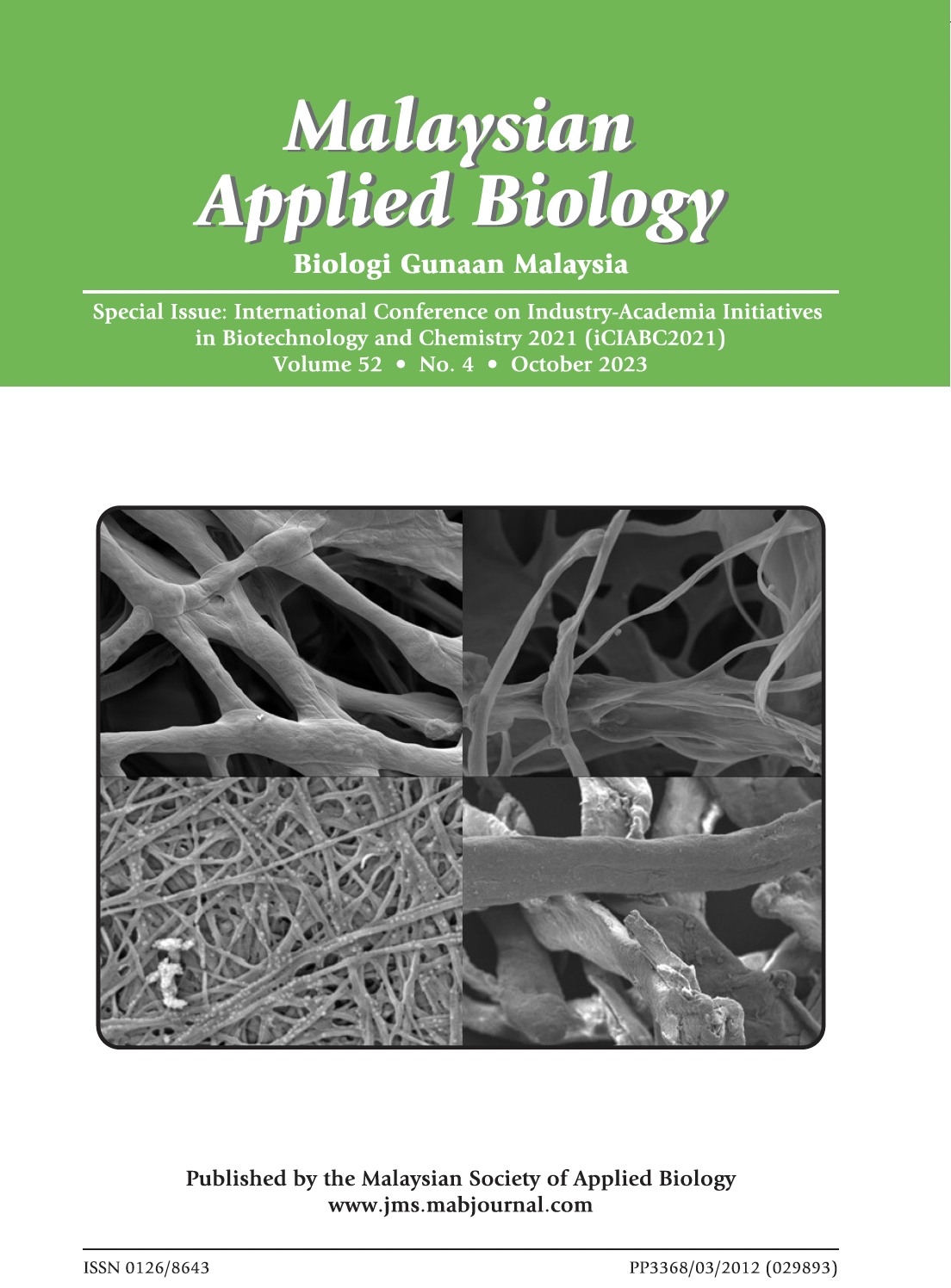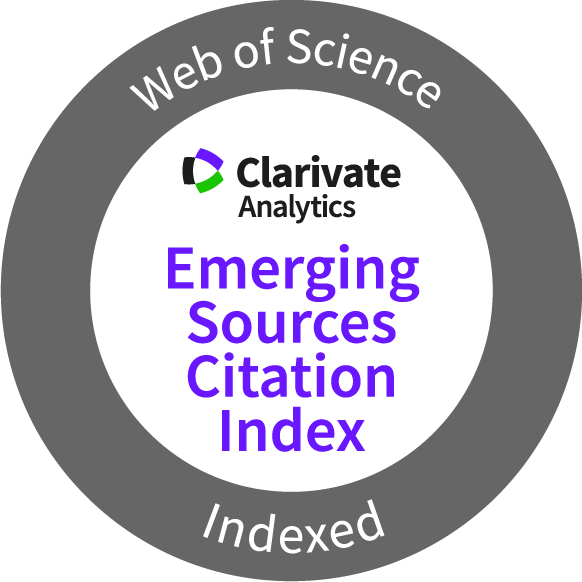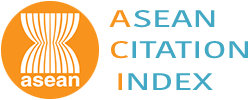Preliminary Assessment on Pretreatment Methods For Landfill Waste Utilization in Biohydrogen Production
Keywords:
biohydrogen, landfill watse, pretreatment, value-added productAbstract
Landfill waste consists of a mixture of components that have high potential as a substrate for hosting various microorganisms’ growth. Utilizing this waste as a fermentation substrate is seen as an economical solution for the management of the waste. Treating this waste is crucial to remove unnecessary components for the growth of specific organisms to ensure a high reaction yield. Fermentative hydrogen production from this waste specifically requires the hydrogen-consuming bacteria to be reduced. In this work, heat, ultraviolet (UV) radiation, acid, and alkaline pretreatment were conducted on the landfill waste. The changes in the reduced sugar content and appearance of bacterial colonies were observed and compared. Heat pretreatment at 65 °C was found to give among the best increase (74 – 88%) in reducing sugar content and reduction (50 – 85%) in the number of aerobic bacterial colonies detected. Global warming potential and eutrophication potential recorded from simulated heat pretreatment plant was comparable to other heat-based pretreatment reported by other researchers with a potential reduction in severity as the plant size increased.
Downloads
Metrics
References
Baghchehsaraee, B., Nakhla, G., Karamanev, D., Margaritis, A. & Reid, G. 2008. The effect of heat pretreatment temperature on fermentative hydrogen production using mixed cultures. International Journal of Hydrogen Energy, 33(15): 4064–4073. DOI: https://doi.org/10.1016/j.ijhydene.2008.05.069
Bare, J., Young, D. & Hopton, M. 2012. Tool for the Reduction and Assessment of Chemical and other Environmental Impacts (TRACI) User’s Manual. US Environmental Protection Agency, Washington, DC.
Baruah, J., Nath, B.K., Sharma, R., Kumar, S., Deka, R.C., Baruah, D.C. & Kalita, E. 2018. Recent trends in the pretreatment of lignocellulosic biomass for value-added products. Frontiers in Energy Research, 6: 141. DOI: https://doi.org/10.3389/fenrg.2018.00141
EPA, 2020. Direct Emissions from Stationary Combustion Sources, U.S. EPA Center for Corporate Climate Leadership - GHG Inventory Guidance.
Han, W., Yan, Y., Shi, Y., Gu, J., Tang, J. & Zhao, H. 2016. Biohydrogen production from enzymatic hydrolysis of food waste in batch and continuous systems. Scientific Reports, 6: 38395. DOI: https://doi.org/10.1038/srep38395
Hu, C.C., Giannis, A., Chen, C.L. & Wang, J.Y. 2014. Evaluation of hydrogen producing cultures using pretreated food waste. International Journal of Hydrogen Energy, 39(33): 19337–19342. DOI: https://doi.org/10.1016/j.ijhydene.2014.06.056
Kapdan, I.K. & Kargi, F. 2006. Bio-hydrogen production from waste materials. Enzyme and Microbial Technology, 38(5): 569–582. DOI: https://doi.org/10.1016/j.enzmictec.2005.09.015
Kucharska, K., Rybarczyk, P., Hołowacz, I., Łukajtis, R., Glinka, M. & Kamiński, M. 2018. Pretreatment of lignocellulosic materials as substrates for fermentation processes. Molecules, 23(11): 2937. DOI: https://doi.org/10.3390/molecules23112937
Mahmud, N. & Rosentrater, K.A. 2020. Life-cycle assessment (LCA) of different pretreatment and product separation technologies for butanol bioprocessing from oil palm frond. Energies, 13(1):181. DOI: https://doi.org/10.3390/en13010181
Mohamed Usman, T.M., Kavitha, S., Rajesh Banu, J. & Kaliappan, S. 2020. Valorization of food waste for biogas, biohydrogen, and biohythane generation. In: Food Waste to Valuable Resources Applications and Management. J.R. Banu, G. Kumar, M. Gunasekaran & S. Kavitha (Eds.). Academic Press. pp. 15–38. DOI: https://doi.org/10.1016/B978-0-12-818353-3.00002-X
Norsa’adah, B., Salinah, O., Naing, N.N. & Sarimah, A. 2020. Community health survey of residents living near a solid waste open dumpsite in Sabak, Kelantan, Malaysia. International Journal of Environmental Research & Public Health, 17(1): 311. DOI: https://doi.org/10.3390/ijerph17010311
Pachapur, V.L., Kutty, P., Pachapur, P., Brar, S.K., Le Bihan, Y., Galvez-Cloutier, R. & Buelna, G. 2019. Seed pretreatment for increased hydrogen production using mixed-culture systems with advantages over pure-culture systems, Energies 12(3): 530. DOI: https://doi.org/10.3390/en12030530
Preethi, Mohamed Usman, T.M., Rajesh Banu, J., Gunasekaran, M. & Kumar, G. 2019. Biohydrogen production from industrial wastewater: An overview. Bioresource Technology Reports, 7: 100287. DOI: https://doi.org/10.1016/j.biteb.2019.100287
Rebecca, L., 2021. Climate Change: Atmospheric Carbon Dioxide [WWW Document]. Climate.gov. URL https://www.climate.gov/news-features/understanding-climate/climate-change-atmospheric-carbon-dioxide (accessed 12.4.22).
Rodrigues Gurgel da Silva, A., Giuliano, A., Errico, M., Rong, B.G. & Barletta, D. 2019. Economic value and environmental impact analysis of lignocellulosic ethanol production: assessment of different pretreatment processes. Clean Technologies and Environmental Policy, 21: 637–654. DOI: https://doi.org/10.1007/s10098-018-01663-z
Sołowski, G., Konkol, I. & Cenian, A. 2020. Production of hydrogen and methane from lignocellulose waste by fermentation. A review of chemical pretreatment for enhancing the efficiency of the digestion process. Journal of Cleaner Production, 267: 121721. DOI: https://doi.org/10.1016/j.jclepro.2020.121721
Stiling, P. 2009. Greenhouse Gases, Global Warming, and Insects. In: Encyclopedia of Insects. 2nd Ed. V.H. Resh & R.T. Cardé (Eds.). Elsevier Inc. pp. 428-431. DOI: https://doi.org/10.1016/B978-0-12-374144-8.00121-1
Su, X., Zhao, W. & Xia, D. 2018. The diversity of hydrogen-producing bacteria and methanogens within an in situ coal seam. Biotechnology for Biofuels, 11: 245. DOI: https://doi.org/10.1186/s13068-018-1237-2
Wong, Y. M., Juan, J.C., Ting, A. & Wu, T.Y. 2014. High efficiency bio-hydrogen production from glucose revealed in an inoculum of heat-pretreated landfill leachate sludge. Energy, 72: 628–635. DOI: https://doi.org/10.1016/j.energy.2014.05.088
Wong, Yee Meng, Wu, T.Y. & Juan, J.C. 2014. A review of sustainable hydrogen production using seed sludge via dark fermentation. Renewable and Sustainable Energy Reviews, 34: 471–482. DOI: https://doi.org/10.1016/j.rser.2014.03.008
Wu, K.J. & Chang, J.S. 2007. Batch and continuous fermentative production of hydrogen with anaerobic sludge entrapped in a composite polymeric matrix. Process Biochemistry, 42(2): 279–284. DOI: https://doi.org/10.1016/j.procbio.2006.07.021
Published
How to Cite
Issue
Section
Any reproduction of figures, tables and illustrations must obtain written permission from the Chief Editor (wicki@ukm.edu.my). No part of the journal may be reproduced without the editor’s permission





















